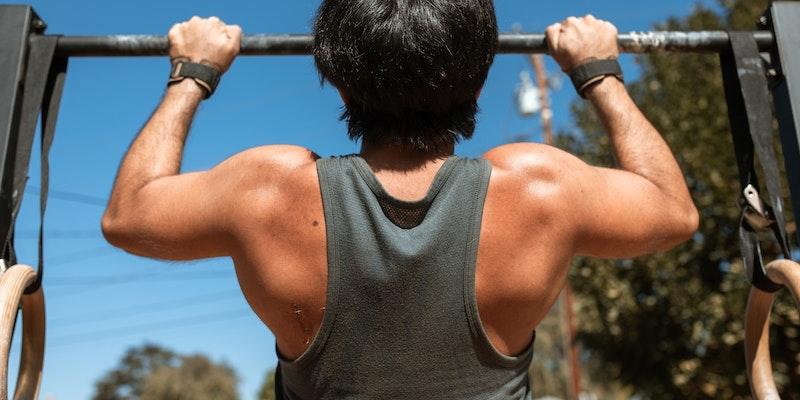Upper-body strength exercises like pull-ups are classic and practical. Though difficult, they can be achievable and beneficial for beginners. This article provides complete pull up exercises instruction for beginners.
The Benefits of Pull-Up Exercises
Many workouts include pull-ups for a reason. They have potent benefits and aren't just for gym showoffs. List the main benefits of doing pull-ups.
Strengthens Upper Body Muscles
Regular pull-ups build upper body strength. Pulling yourself up works multiple muscle groups, making it a complete workout. This helps you do more pull-ups and other daily tasks over time.
Improves Core Stability
Pull-ups focus on the upper body, but the core is crucial. Pull-ups strengthen your core muscles. Better posture and fewer back injuries result from a strong core.
Improves Grip Strength
Ever struggle with a tight jar lid? Pull-ups may help. Holding and pulling on the bar strengthens the grip and works the arms. This can help with grocery shopping and rock-climbing.
Pull-Ups for Beginners: Getting Started
No worries if you're new to pull-ups. Like any exercise, the beginning is about learning the basics and building a solid foundation. Here's a simple guide to ease into pull ups for beginners.
The Right Equipment
Ensure you have the right gear before starting any pull up exercises workout. A robust pull-up bar is essential. There's a range to choose from: some can be fixed to doorframes, while others are standalone structures. Prioritize a bar that seamlessly fits within your space and can reliably bear your weight.
Grip Techniques
Knowing how to grip the bar is foundational. Two main grips are predominantly used:
Overhand grip (pronated)
This grip involves your palms facing away, providing a broader range of muscle engagement.
Underhand grip (supinated)
In this grip, your palms face you, and it tends to focus more on the bicep muscles.
Techniques for Beginner Pull-Up Exercises

Embarking on your journey with pull-ups might seem daunting initially, but the key lies in breaking it down and starting small. For many, diving straight into a pull up exercises is out of reach. However, a range of preliminary exercises are explicitly designed to build strength and confidence, eventually leading to the real deal. Let's guide you through some fundamental techniques tailored for those new to the world of pull-ups.
Dead Hang
Beginners start pull-ups with the dead hang. Take a firm overhand or underhand grip on the bar. Hang freely with your feet off the ground. Be aware of your body weight and arm and shoulder tension. This position prepares you for more advanced pull-ups, so get comfortable. Grip strength and stamina improve over time. Introduce yourself to pull-ups with this simple but effective method.
Negative Pull-Ups
After mastering the dead hang, the next progression in pull ups for beginners is the negative pull-up. Start by getting yourself to the topmost position of a pull-up, either by jumping or using a step. The goal here isn’t to pull yourself up but to control your descent. Lower your body down as slowly and controlled as possible. This technique primarily strengthens the muscles during the lowering phase and prepares them for the entire motion of a pull-up. While it might seem like you’re doing things in reverse, negative pull-ups are valuable in building the strength required for full pull-ups.
Assisted Pull-Ups
Only some have the initial strength to perform a complete pull-up. This is where assisted pull-ups come into play. Using tools like a resistance band or a specific pull-up assist machine, beginners can experience the motion of a pull-up with some assistance. You can reduce the assistance as you progress until you perform pull-ups unaided. It's a gradual process, but with consistency, the assisted pull-ups bridge the gap between beginner techniques and the actual pull up workout.
Common Mistakes and How to Avoid Them
While enthusiasm is great, ensuring you’re doing pull-ups the right way is equally crucial. Incorrect techniques can not only hamper progress but also lead to potential injuries. So, as you get started with pull ups for beginners, it's beneficial to be aware of common pitfalls and how to steer clear of them.
Not Fully Extending Arms
The essence of a good pull-up lies in the range of motion. Start from an utterly extended arm position, also known as a full hang. As you pull yourself up, aim for the chin above the bar. Completing the motion ensures that the muscles work effectively. Half-pull-ups might seem more manageable, but they rob you of the full benefits of the exercise. Commit to the entire motion, and you’ll witness better results from your pull up workout.
Using Momentum
Momentum is a common beginner mistake. Swinging or kicking the legs may make the pull-up seem more manageable, but it detracts from its primary purpose. The goal is to lift with upper-body strength. Aim for a controlled motion without swings or jerks when you're on the bar.
Not Engaging Core
While pull-ups are primarily an upper-body exercise, the role of the core cannot be sidelined. A tight, engaged core offers stability and balance as you pull yourself up. Neglecting the core can lead to a shaky motion, making the pull-up more challenging and less effective. As part of your pull-up exercises, always tighten your abdominal muscles as if preparing for a punch. This small yet crucial step can significantly elevate the quality of your pull-ups.
Formulating a Pull-Up Workout Routine

When it comes to fitness and particularly pull-up exercises, every individual's journey is unique. Your path with pull-ups, especially if you're a beginner, should be marked with patience, practice, and persistence. While the ultimate aim might be to achieve a perfect pull-up, the journey is equally important. Here’s a simple guide to help you set a routine tailored for success.
Start Slow
In the world of pull-up exercises, rushing isn’t an option. As a beginner, it’s crucial to take baby steps. Familiarize yourself with foundational exercises like dead hangs and negative pull-ups. The beauty of these preliminary workouts is that they prep your muscles for the intensity of a full-blown pull-up. Remember, Rome wasn’t built in a day. Similarly, your pull-up strength won’t develop overnight. Prioritize mastering the basics first before climbing up the pull-up ladder.
Incorporate Rest
Resting muscles repair themselves, not working out. Thus, pull-ups must be balanced with rest. Overworking may seem like a quick fix, but it can backfire. Rest is essential to pull-up training. Pay attention to your body. Give tired muscles time to recover. Resting strengthens you for your next session, reducing injury risk.




